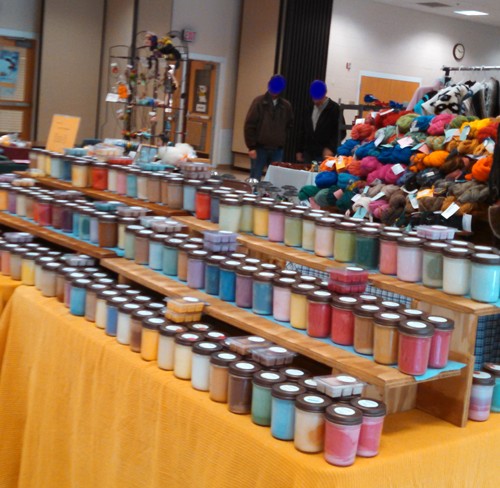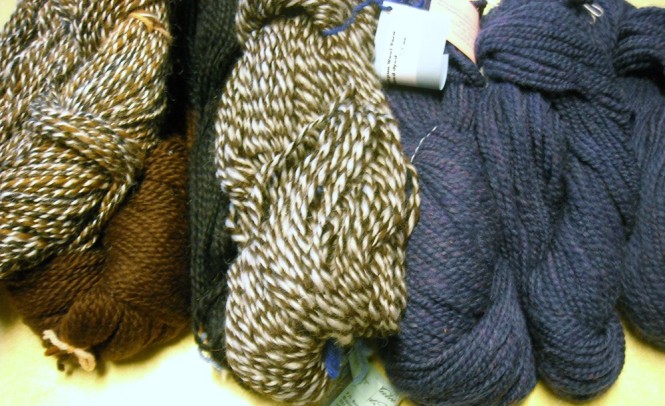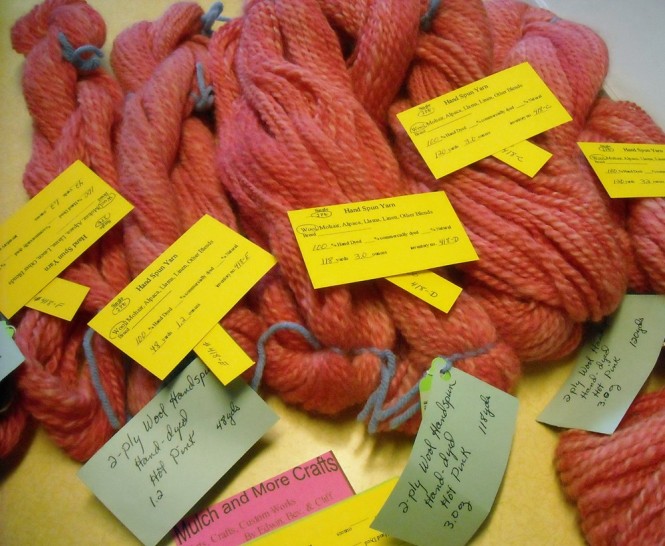One of my goals this year is to improve my organization of inventory. As a business I need to have control of my inventory. Although most of what I make has a long shelf life, instead of making what I enjoy, and struggling to make more of other things before the next show, I’ve decided to better track the specifics of things I sell and develop an inventory par level, to relieve some of the stress between back-to-back shows. Of course I will still be developing new projects as well as tweaking older ones, since another part of business is constant change. With a better inventory system I should be better able to see where I’ve been as well as where I’m going.
Last year I made a spread sheet for candle inventory. Instead of just writing down the scents I sold at each show (as I had in years past) I began by listing all of my scents (over 100), included my beginning inventory, my sales of each for each month, and the number of each made each month. Then I had a running inventory to tell which ones needed to be made next. (Yes, this could be done in excel, but was easier for me to track by paper & pencil/pen on a columnar pad.) This year I have plans for slight changes which should make inventory keeping easier yet.

Free smells of Soy Candles
Now at the end of the year, I have a complete picture, not only of my best sellers (which tend to vary from year to year) but also of the monthly and seasonal variations which will allow me to better tailor my production for this year.
With candles somewhat under control, I decided that yarn needs to be my next challenge…..I spin a lot more than I realized, both at craft shows and at home.
I have more than five 18gal totes of yarn that I have spun over the last several years. (Plus a smaller amount that I have listed here and here. Starting with the five craft show totes, I emptied them on the table, one at a time, sorting them by color.
Then I started taking each color and dividing the skeins into families by color (dye lot) and fiber type, assigning a “parent” number and sub-numbers, and recording the pertinent information on a spread sheet. This way with a quick look at the parent number, I can tell a customer how many skeins of a particular yarn is available, whether it is in my back stock or listed on line.

sorted into reds and greens
The greens and the reds are completed (unless I find more in hiding). I am pulling some skeins to use in knitting hats and cowls. It’s a good way to display how well the yarn works, and gives me a better idea of the yardage needed for a project (although this will vary with pattern and individual gauges.) But best of all, I have the enjoyment of working knitting with my own yarn; A skein with no knots, easy to wind into a ball without tangles because of the way I wind my skeins from my spools. And I see how the shades of color work together to enhance the pattern, forming an unique project.

Some of my added stash
(Hover mouse on pictures below to read captions)
Organization is a lot of work, especially when I get distracted with knitting 🙂 Two totes turned into two and a half, plus a bag of stash for me. I have only three totes plus a small box left to do. It is progressing quicker than when I was handwriting everything on my old labels.

new yellow tags ready to replace the old handwritten ones.

yarn and my inventory tools
Once finished I will know which colors I need to dye more of to spin. This leads to the roving totes that will next need to be “organized”! Then there’s hats etc that need their own spreadsheet!
As I create, I’ve also created “the never-ending organizing-inventory monster”! (I do like red though 🙂 All a part of growing a business I guess!
What inventory and organizing secrets have you discovered? Please share in a comment.





The last fifteen years of so in my work career has been mostly devoted to managing and planning inventory. The items you are keeping track of are ones I have not worked with before but basic principles of inventory don’t change. Decide the best unit of measure for all your yarn and then be consistent, consider a two bin system both stocked with equal amounts so when one bin is empty you automatically reorder more and allow for the time to get it before you run out of the second bin amount…and if you use some yarn for multiple uses set a higher level of “safety stock” in those bins to allow for a variance in consumption. Good luck!
LikeLiked by 1 person
Thank you for the information, but it is a little harder for me to apply. I don’t order my inventory. I make the yarn on a foot-treadled spinning wheel from wool or alpaca, or llama, or even flax. My yarns are one of a kind or limited editions. They are different sizes to allow customers to choose a size to fit their specific needs and to allow for the different yardages that each dye lot makes. People who buy hand spun yarn are looking for quality yarn in unique colors and styles, not the mass produced cookie-cutter products that can be found cheaply in large stores.
With the candles, I keep a supply of wax, jars, and scents and make enough to have safety stock. Yes, I make the candles consistent using family developed recipes and techniques.
Doing craft shows is a different type of business than traditional retail. If you don’t have it on hand people can’t come back next week to pick it up since then we will be in a different town, with a different set of customers. I do a limited number of custom orders to ship as well as some on-line sales. After more than 20 years of doing craft shows, we are still changing some of the ways that we do things, and no I don’t display my complete inventory at a show, but do keep back-stock with us.
LikeLiked by 1 person
That is a fascinating challenge to anticipating what amounts of yarn will be sold at any given time. Any “forecast” is a guess, you just try to make it as intelligent a guess as possible..lots of times prior sales is all you have to go on. Very interesting and I am sure even after two decades you’re still learning better ways to running the business!
LikeLiked by 1 person
This is awesome!
You are very welcome to visit and dive into my wool stash. Reorganisation is urgently needed. You gave me some really good ideas how to go about. So thank you 🙂
LikeLiked by 1 person
Thank you for understanding our never ending battle! Together we can at least control, if not overcome the monster stash 🙂 Are you a spinner too?
LikeLike
Yes, I am afraid I am a spinner too 🙂 Both dropspindel with or without distaff and wheel. But just for hobby. My yarn is not very even so far but getting there.
I also dye (with plants), knit, crochet, needlebind, net, sprang, weave, tablet weave …
And I am either a woolaholic or on my way of becoming a sheep myself O.O
LikeLiked by 1 person
Wow, this is amazing! You’ve done great work, and I have found you on Etsy for when I can buy new yarn. 🙂 Just a thought: you might consider making your links jump to a new page. When I clicked on them to find where your yarns are listed, I lost the blog page & had to go back.
LikeLiked by 1 person
Thanks bonnyknits. (If you don’t see it listed in one of my shops but saw a blog picture just contact me with a description and I can list it for you-I should be organized enough to find it by then 😉
Being new to blogging I don’t know how to make my links jump to a new page, please contact me if you know how?…I usually right click on links and choose open in a new tab to avoid that happening to me.
LikeLike
I blog on my laptop, and to insert a link, I select the text, click the link icon at the top, and when the box opens, there should be a little check box at the bottom to “open link in new window” (or tab, I don’t remember the wording). Let me know if you need more; I can try to do it on my iPad and take a screenshot.
LikeLiked by 1 person
Bonnyknits, So that’s what that box means, I think I have it fixed. Thanks.
LikeLike
portapatetcormagis, Wow, sprang, naalbinding and card weaving are things I haven’t learned yet! Do you attend re-enactment type events? As to uneven yarn, that is normal for beginners (and is great to weave with or knit something extra textured) when you ply it, it will even out some, and with practice it will become harder to spin unevenly, so cherish that beginning yarn 🙂
A fellow fiberholic- isn’t it great?
LikeLike
Yes it is 🙂
I have been an active reenactor for about 13 years now. “My time” is ca. 280 b. c. and 530 a. d. This is where I met these old techniques.
I can acutally use my yarn for knitting by now which is quite nice. I have great help from friends in a spinning group. They are taking art yarn courses to learn what I try to smooth out *lol*
LikeLiked by 1 person
Isn’t reenacting fun? I’ve done colonial times for many years now and was introduced to a Vikings group (that I think is between 600 and 1600ad) a few years ago. Vikings is where I saw examples of sprang and sat in on part of a class on naalbinding (I was there as a merchant so couldn’t learn the whole time!) Yes, having learned to spin as a teen, I really have trouble doing an “art yarn” LOL! And spinning groups are great -amazing how many different techniques people use.
LikeLiked by 1 person
[…] Mulch and More Crafts […]
LikeLike
Congratulations on being Danny Ray’s featured blogger. I was his featured blogger too.
Maybe you can check out my blog if you need a blogging tip or two. That’s what I write about.
Janice
LikeLiked by 1 person
Hi Janice, thanks for stopping by. I’ve basically taken the summer off from blogging to do craft shows but should be more active here in the winter months.
LikeLike